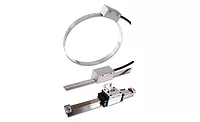Operations
Automated palletizer systems optimize manufacturing, save time
Increased efficiency, space utilization improve operations

As SKU-proliferation and merger/acquisition activity throughout the beverage manufacturing and distribution markets increases, more operations are not only seeing the value of investing in automation, but also the need for it. In addition, more recent outlying factors such as mixed-SKU pallets and even COVID-19 conditions are piquing demand for automated palletizers and depalletizers.
“Shipping products from distribution centers to retail outlets is a growing trend, with pallets of products with mixed-SKU loads shipped at a quickening rate,” says Dean Elkins, segment leader of material handling at Yaskawa America Inc., Miamisburg, Ohio. “A high mix of product requirements with a more open work-cell design accelerates the utilization of collaborative palletizing robots, which are easy to program and allow for quick product changeovers.”
However, a vast portfolio is not the only growing pain impacting beverage operations. Matt Halley, general manager at Allied Technology LLC, Broomfield, Colo., notes that COVID-19, a lack of reliable workers, increasing minimum wage and workers’ comp costs, along with food safety issues in the food and beverage space have resulted in a greater demand for automated palletizers.
“There’s also been a decrease in price for the machines and increased usability in the future for the same machine on different products and areas,” he says.
Beyond this, palletizers deliver added efficiency and practical space usage, Yaskawa’s Elkins says. For example, safety fencing traditionally placed around a palletizer can sometimes be eliminated, allowing more open floor space. Other advantages include offline programming, which eliminates the need to take down the palletizing operation to reprogram new patterns, he notes.
A vital role
Although needs vary across industries, palletizers hold an important role in food and beverage. Both food and beverage industries share the need to balance throughput and product weight, according to Elkins, which comes back to SKU handling.
“There is a growing need to address multiple SKUs on the same pallet, particularly on the distribution side of the business,” he says. “In some cases, particularly in the food and beverage industries, robots that operate with food-grade grease are required to simplify maintenance tasks across the plant while adhering to specific sanitation standards.”
Among other issues, Halley cites food safety, ergonomics and cost-efficiency as being paramount to palletizing equipment. .
“There’s also the matter of consistency of quality and accuracy of operation; food and beverage is a pennies game, and not running at 100 percent efficiency really hurts margins,” he says. “Palletizers now enable complete changeovers with a few button pushes, requiring minimal training and maximum uptime of the machine. [Allied Technology] sets up new customer box sizes, patterns and tools in just hours when new products or patterns are introduced.”
Having a consistent machine that picks and places products exactly where they need to go reduces downtime and boosts efficiency, Halley adds.
These benefits are helping to contribute the growth of the global palletizer market. Hyderabad, India-based Mordor Intelligence’s “Palletizer Market - Growth, Trends and Forecast (2020 - 2025)” report states that the palletizer market accounted for $2.37 billion in 2019 and is projected to exhibit a 5.34 percent compound annual growth rate from 2020 to 2025, resulting in a $3.27 billion market size. The market research firm cites “Industry 4.0,” the automation of material handling and a decade-long 25 percent decrease in workplace injuries due to the advent of workplace technology among the factors contributing to this projected growth.
Challenges and considerations
Before initiating a new palletizer system, businesses should take into account several challenges and considerations. For one, high equipment cost coupled with high maintenance cost can act as a restraint for some businesses. In addition, Elkins notes palletizers have height restrictions, so sufficient ceiling height is required for the robot to build a full pallet load.
The following are other key considerations Elkins cites:
- Product rate (parts per minute) and weight: Does a robot have the correct payload to meet the rate and weight requirements of the application?
- Product mix: Are palletized loads homogenous product or mixed?
- Load height: Is a slip sheet required, and can the robot reach all the required locations in the work-cell for product and slip sheets?
- Work-cells: How will empty and full pallets be introduced into the work-cell and removed from it?
- Programming: What programming skills does the company’s labor pool possess?
As operators look to invest in palletizing and depalletizing equipment, Allied’s Halley says advancements such as becoming collaborative (safe to operate next machines and humans), mobile (moved to production line needing to be palletized), and more compact, affordable and easier to use will ingratiate the technology to decision makers.
He adds that Allied is scaling to have multiple robots from different robot companies work seamlessly with their palletizer design(s), and has seen growing interest in Universal Robots UR10e and the new Yaskawa HC20XP.
“Our PicPac Palletizer using a Universal Robots UR10e handles up to 10-kg payloads, and paired with a Yaskawa HC20XP, can handle up to 20 kg,” he notes. “Engineers also can build new picking patterns in minutes with PicPac Pattern Builder software.”
Halley anticipates use of these types of products will boom, especially as operations deal with COVID-19 and resulting unreliable labor issues.
Yaskawa’s Elkins agrees, noting that all industry studies he’s seen point to stable continued growth of robotic palletizer utilization.
“Continued ease-of-programming tools, as well as the development of power- and force-limiting collaborative robots, will make it easier than ever to deploy palletizing systems while incrementally reducing cost,” he concludes.
Looking for a reprint of this article?
From high-res PDFs to custom plaques, order your copy today!






